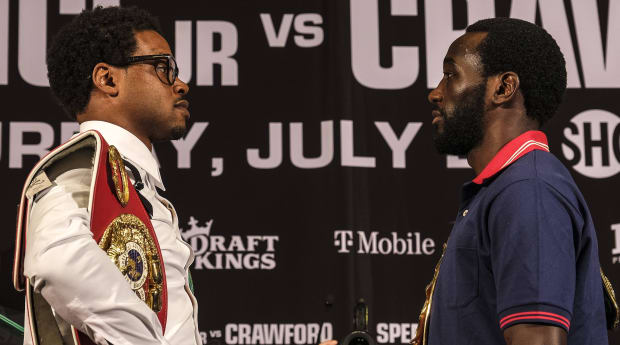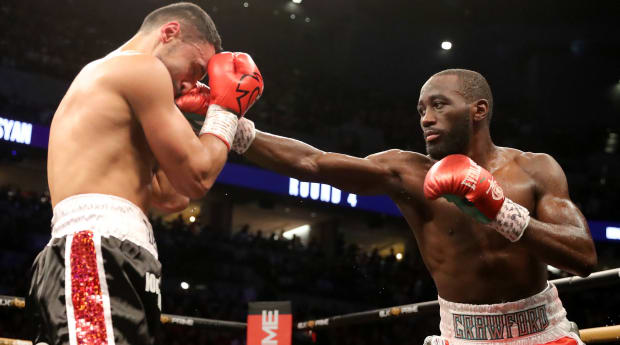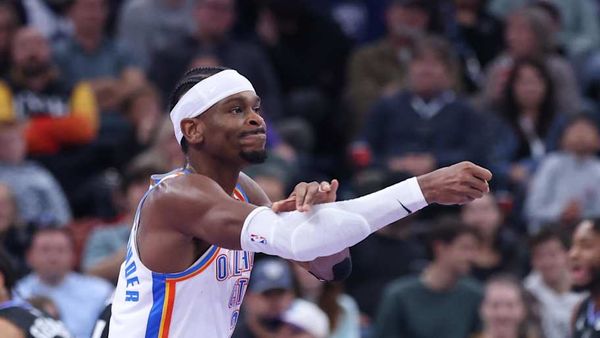Terence Crawford has a lot to say—about his career, how it’s perceived, his upcoming clash with Errol Spence Jr. and the most coveted qualifier in his sport. Boxing, of course, needs some sort of title company for all the belts and designations that can be won. But start with this: As far as undisputed goes, Crawford says, “I feel as if I started that trend; a massive feat.”
He’s right. But there’s context. The first sentence in this paragraph followed by the second is very #boxing, meaning the context matters, because narratives are shaped, shifted and sold in every possible way except in relation to each other. Because what’s said in March of one year is altered the next January. Because what’s peddled matters most as it relates to profits.
He’s right, in that seizing an undisputed championship—or holding all four major belts at the same time—ranks among boxing’s most difficult aspirations. It involves managers and promoters, previous bouts and desired ones, not to mention skill, timing, work, egos, support staff, negotiations, networks, health, recovery, money, performance, follower counts, reputations and the alignment of stars in boxing and more cosmic senses.
To simply fight for an undisputed title marks a heroic confluence of events. And, at that point, somebody still has to win. Some undisputed titlists must triumph more than once. Canelo Álvarez became one by winning four times in 12 months, picking up one belt each time at an astonishing clip.
But as in all things #boxing, there is context. Critical, fungible, shape-and-shift contrast. It’s true that only nine male and eight female boxers have claimed the WBA, WBC, IBF and WBO belts simultaneously. It’s true that Crawford became the first undisputed champion in 12 years back in 2017, when he captured four belts at junior welterweight. It’s true that six of the nine undisputed male champions—Oleksandr Usyk (cruiserweight), Josh Taylor (junior welterweight), Álvarez (super middleweight), Jermell Charlo (super welterweight), Devin Haney (lightweight), Naoya Inoue (bantamweight)—did so after Crawford did it first.

Adam DelGiudice/ZUMA Wire/IMAGO
It's also true that the four-belt era didn’t start until 1998, when the WBO belt was created. It’s also true that the WBO was recognized by the other three organizations as their equal in different years—by the WBA, in 2001; the WBC, in ’04; the IBF, in ’07—which meant confusion around when four belts became equal and when the four-belt era truly started. It’s also true that this alphabet soup mix is deployed, often intentionally, as a sleight of hand. Did the WBO matter in 1998? In 2001? In ’04? Who knows? That’s the point. Promoters, managers, fighters and everyone else with a stake in boxing can make these events into whatever they want, for that very lack of definition.
All things are true. Boxing critics who rail against the sport’s confusion, noting that the top fighters today fight one another far less often than they used to, as recently as the mid-2000s. That’s true. Boxing supporters can rail against the blowback, with a fair number of so-called super-fights held in the past four years alone. That’s also true.
The boxing-is-dead crowd isn’t wrong when examining the sport compared to its incomparable heyday, or pointing out the numerous unforced errors made by many all the time (controversial judging, alphabet city, no central governing body, yearslong negotiations, celebrity boxing matches, etc.). The boxing-is-dead crowd has also always been wrong on this screed, at least when looking at objective numbers like revenue for pay-per-view fights, highest-paid athletes in any one year, sold-out arenas all over the world and the massive, massive attention a bout like Crawford-Spence will generate before they clash July 29.
This is, undoubtedly, no reservations, a huge fight. In boxing history, only three other welterweight unification bouts have been staged between unbeaten champions before this one. Crawford and Spence boast of more combined victories at the time of their unification than any of the others. Crawford can even become the first male fighter in this four-belt era to win undisputed twice, at different weights. There is, as he says, no need to sell this fight. And yet, in some ways, it’s being oversold; specifically, in regard to its historical significance. The oversell, meanwhile, threatens to undo momentum, rather than build on it.
The contrast owes to the most definitive of sports—hit, get hit, hit back—and the most abstract of governance. Which leads perfectly into the career of Terence Crawford. A career tinged by violence, promotional issues and typical #boxing issues but defined by greatness, at its core, whether forming, formed, summoned or otherwise. It’s similar, the way Crawford is often viewed and how undisputed titles have been won more often recently, boxing’s latest not-yet-dead answer to its critics. Context matters. Narratives matter. Truth matters. Good luck finding that!
This is the pattern: Crawford’s next fight is against the biggest, baddest challenger. Said contender is taller, has a longer reach, will jab the smaller Crawford to death. Crawford wins, always; often, easily. He’s fast, skilled, versatile, entertaining, the real deal. But when he wins, this contender is then fashioned into something far worse. They’re definitely not billed as they were heading in. So which is it? Crawford is toppling easy challengers who are over-billed by promoters and boxing media heading into bouts? Or Crawford is making this toppling look easy and being unfairly maligned in the aftermath? It has to be one. And neither speaks highly of the sport.
He laughs over the phone recently. “That’s it. Exactly,” he says. “People always underestimate me, which is natural. Looked at my opponents when I fought them. Look at what people said. Look at who pushed for those exact fights. I just never got any credit from nobody, really, because people are looking at multiple-time world champions after I beat them and saying, he’s washed up, he’s a bum.”

Tom Hogan/IMAGO
Crawford laughs again at the next question. Where did all this come from? This process, all buildup to tear down, isn’t unique to boxing. But the cycles of building and tearing seem shorter now, more condensed. Records appear to matter more than quality wins, especially when quality wins are disregarded. “Floyd Mayweather made that a trend of, you’ve got to be undefeated,” Crawford says. “Why? Because it made him a lot of money. And, to him, money is success.”
I am, by no means, a boxing historian. But I’ve spent a few hundred days in gyms with boxers, and I’ve covered more than 25 world title fights. And, in speaking with actual boxing historians (and actual boxers and their trainers), Sugar Ray Robinson is regarded by the majority—a significant majority, I would argue—as the greatest fighter who ever lived. He lost 19 times. He also won 174 bouts. Personally, I hold a tremendous amount of respect for Mayweather’s boxing acumen and defensive wizardry, setting aside his promotional brilliance and out-of-ring arrests and misbehavior. But I’ve never heard someone who really knows boxing put him in their top five.
Álvarez is another important example of the landscape. For most of his career, he took on—and won, mostly—the toughest fights available. He lost to Mayweather when he was only 23 years old. He fought Gennadiy “GGG” Golovkin three times (split draw, majority decision, unanimous decision). His undisputed title is actually less significant than the trilogy and other wins. Impressive? Absolutely. An all-time-classic performance worthy of, say, the welterweight heyday of the 1980s in comparison? Absolutely not.
That’s #boxing. Not all belts are created equal. Nor all undisputed titles. Or maybe they’re created that way, but sold in numerous other ways, with varying levels of success. I asked Crawford whether boxing’s last mega-bout, between Gervonta “Tank” Davis and “King” Ryan Garcia, was the same as Crawford-Spence. I’d argue Garcia-Davis was a massive event between two of boxing’s most popular fighters and one of its best, Davis, who triumphed by seventh-round knockout. I’d also argue that Crawford-Spence is a level above that, between two of, if not the two very best, active boxers in the world.
“There’s different calibers of fighters,” Crawford says. “That fight was great for the media and the fans that both of them have. But for us die-hard boxing fans, we all knew how that fight was going to pan out.”
He points to the other elite champions in and around Davis’s and Garcia’s weight class (lightweight), then notes that at welterweight, one of boxing’s most stocked divisions, there’s only him and Spence, alone, together, at the top. Again, not wrong. Hence why this fight is the perfect fight. But check back after and see how many call it that.
So here’s a hope: Let the fight speak for itself. Two of the best boxers in the world, both undefeated, both still in their respective primes, willing to risk their first loss for boxing immortality. Both are elite counter-punchers. Both have shown power. Both display excellent footwork. And both would be all those things, do all those things, whether the undisputed title was being pushed and pushed (and pushed) or not.
Here's another hope: Perhaps soon a wider audience will recognize the gifts Crawford possesses. I wouldn’t argue that his résumé contains as many significant wins as Spence’s does. But to say he hasn’t fought anybody, that he lacks a career-defining fight, isn’t fair to him. How about knocking out beefy bruiser Shawn Porter? Doing the same to a much larger man in Kell Brook? Smashing Amir Khan closer to retirement? What if Felix Diaz didn’t lose in his next bout after Crawford? What if Crawford didn’t push Viktor Postol into a spiral toward irrelevance? It’s all narratives, framework, shaping and shape-shifting. None of it changes what Crawford did; only how he’s viewed.
That’s what matters in the Spence fight—the legacy Crawford can redefine, enhance, polish. Not the billboards in Times Square featuring the duo’s press conference in New York. Not the jokes about fish filets (Spence’s nickname is The Big Fish) or a Craw-fish boil. Not the “biggest fight” in modern boxing, which is taking place after the last one, from last month, which comes on the heels of the one before that, which undoubtedly was billed that way at some point last year.
Can’t we just dispense with all the nonsense and appreciate these two champions for what they’ve done, what they’ve overcome and who they are? Probably not, which is a shame. Because while many argue over whether boxing is dead, whether it’s relevant or whether it’s now deep into a full-sport revival, all the debaters are missing out. Because in the end, boxing matters, not belts, undisputed titles or any of the hoopla that will almost certainly be altered in the aftermath. If the focus could linger on actual fights, the in-ring action and nothing else, then the other questions would cease to matter. Or wouldn’t matter as much.
“It’s all about this fight,” Crawford says. “Everything.”
For one, glorious night, at least—the kind that made boxing a sport that people can now say died/is dying/will never die. Without boxing, it’s just debate. Mindless, pointless, ever-shifting arguments. Packing disguised as athletics. These conversations are grounded in something. But it’s not sport.
The perfect fight, as is, should be enough.







